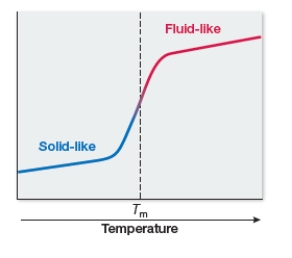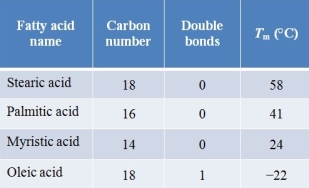Refer to the figure and table below. 
 At low temperatures, cell membranes become quite immobile and solid-like.If the temperature is gradually increased, a membrane undergoes small changes until a large change in fluidity is observed.The midpoint temperature corresponding to this large change is called the melting temperature.The graph shows how a cell membrane's melting temperature (Tm) is measured.The table shows melting temperature data collected from membranes composed of phospholipids containing different fatty acids.Which statement is consistent with these data?
At low temperatures, cell membranes become quite immobile and solid-like.If the temperature is gradually increased, a membrane undergoes small changes until a large change in fluidity is observed.The midpoint temperature corresponding to this large change is called the melting temperature.The graph shows how a cell membrane's melting temperature (Tm) is measured.The table shows melting temperature data collected from membranes composed of phospholipids containing different fatty acids.Which statement is consistent with these data?
A) Increasing chain length or introducing double bonds into fatty acids in membrane phospholipids increases temperature-dependent membrane fluidity.
B) Increasing chain length or omitting double bonds from fatty acids in membrane phospholipids increases temperature-dependent membrane fluidity.
C) Decreasing chain length or introducing double bonds into fatty acids in membrane phospholipids increases temperature-dependent membrane fluidity.
D) Decreasing chain length of fatty acids in membrane phospholipids increases membrane fluidity, but introducing double bonds has no effect on temperature-dependent membrane fluidity.
E) Increasing chain length of fatty acids in membrane phospholipids increases temperature-dependent membrane fluidity, but introducing double bonds has no effect on fluidity.
Correct Answer:
Verified
Q153: Which molecule can function as a recognition
Q154: Specialized cells in the heart are able
Q155: A protein that forms an ion channel
Q156: Refer to the table below. 
Q157: Which analogy could best be used to
Q159: Cell adhesion in animals often occurs through
Q160: The cell membrane contains carbohydrates, which can
Q161: Refer to the table below. 
Q162: In animal cells, tight junctions and desmosomes
Q163: Refer to the figures below. 
Unlock this Answer For Free Now!
View this answer and more for free by performing one of the following actions

Scan the QR code to install the App and get 2 free unlocks

Unlock quizzes for free by uploading documents